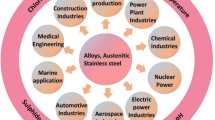We study the corrosion resistance of sintered titanium specimens obtained by the methods of powder metallurgy in a 40% aqueous solution of sulfuric acid and in a 20% aqueous solution of hydrochloric acid at room temperature. It is shown that the modification of the surface layers of sintered titanium specimens by interstitial elements and, especially oxygen, increases their corrosion resistance. The maximum protection effect against aggressive media is provided by an oxide film obtained by thermodiffusion oxidation under the conditions of saturation in the oxygen-containing controlled atmosphere and by the oxidation in air: the corrosion resistance increases by three orders of magnitude as compared with the corrosion resistance of the unprotected surface.







Similar content being viewed by others
References
L. L. Shrier (editor), Corrosion, Butterworth-Heinemann, London (1976).
S. G. Glazunov and V. N. Moiseev, Titanium Alloys. Structural Titanium Alloys [in Russian], Metallurgiya, Moscow (1974).
G. M. Itel’son, Titanium Equipment [in Russian], Mashinostroenie, Moscow, 1964.
O. M. Ivasishin, D. G. Savvakin, K. A. Bondareva, et al., “Production of titanium alloys and workpieces by the economical method of powder metallurgy for wide-scale industrial applications,” Nauka Innov. Innov. Proek. Nats. Akad. Nauk Ukr., 2, No. 2, 44–57 (2005).
O. M. Ivasishin, V. V. Telin, M. V. Matviichuk, et al., “Approbation of powders of hydrogenated titanium produced at the “ZMTK” plant in the technological processes of powder metallurgy,” in: Proc. Internat. Conf. “Ti-2007 in CIS,” Yalta, April 15–18 (2007) [in Russian], Kurdyumov Institute of Metal Physics, Ukrainian Academy of Sciences, Kiev (2007), pp. 73–78.
V. M. Anokhin, R. K. Ognev, and V. P. Salivon, “Titanium products made of powders,” Proizvod. Leg. Tsvet. Met. Élektrod. Prod., No. 2, 23–25 (1984).
O. M. Ivasishin, A. G. Molyar, M. V. Matviichuk, et al., “Titanium porous permeable materials obtained from the blend of TiH2 and Al(C5H7O2)3 powder components,” in: Proc. Internat. Conf. “Ti-2011 in CIS,” Lviv, April 25–28 (2011) [in Russian], Kurdyumov Institute of Metal Physics, Ukrainian Academy of Sciences, Kiev (2011), pp. 19–21.
I. O. Bykov, A. V. Ovchinnikov, S. I. Davydov, et al., “Application of hydrogenated titanium with given contents of oxygen for the production of workpieces by the method of powder metallurgy,” Teor. Prakt. Met., No. 1–2, 65–69 (2011).
P. Kofstad, High-Temperature Oxidation of Metals, Wiley, New York (1966).
Author information
Authors and Affiliations
Corresponding author
Additional information
Translated from Fizyko-Khimichna Mekhanika Materialiv, Vol. 49, No. 3, pp. 63–69, May–June, 2013.
Rights and permissions
About this article
Cite this article
Skrebtsov, A.A., Pohrelyuk, I.M., Luk’yanenko, O.H. et al. Influence of Oxidation on the Corrosion Resistance of Sintered Titanium. Mater Sci 49, 347–355 (2013). https://doi.org/10.1007/s11003-013-9621-3
Received:
Published:
Issue Date:
DOI: https://doi.org/10.1007/s11003-013-9621-3




